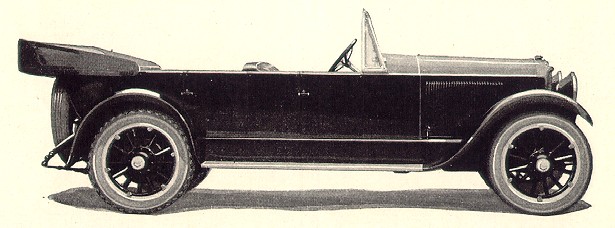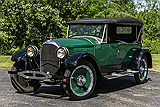| < 1920 | 1922 > |
1921 First Daytona Speedster
| Model: | "6-42" | "6-44" | "6-66" |
| Cylinders: | 6 | 6 | 6 |
| Horsepower SAE: | 43 | 45 | 70 |
| Wheelbase: | 119 | 119 | 131 |
Subtle changes occurred in the cars for 1921, while a new engine made records on the stock car circuit.
Initially the smaller series, the "6-42", was carried forward with five models, ranging in price from $1,770 to $2,645. Standard colors were dark green bodies and black running gear. In late March Paige-Detroit replaced the 6-42 with the 6-44. The 6-44 models had a new engine that produced slightly more power and cost $25-75 more but were otherwise the same, including the model names.
- "6-42" Series
- "6-44" Series
- Touring car, five-passenger, Glenbrook, $1,795
- Sport model, four-passenger, Ardmore, $2,015
- Roadster, two-passenger, Lenox, $1,795
- Coupé, four-passenger, $2,600
- Sedan, five-passenger, $2,720
- "6-66" Series
- Touring car, seven-passenger, Lakewood, $2,795
- Sport type, four-passenger, Larchmont II, $2,895
- Coupé, five-passenger, $3,675
- Sedan, seven-passenger, $3,750
A company brochure described at length one model, the Lenox roadster:
For the medical man, the engineer, contractor or salesman, whose business takes him over a long road daily, and who does his work from his car, there is the Paige 6-44 Roadster. Its single seat is amply wide for three persons, yet the compactness of this body type illuminates that feeling of "carrying weight" so unproductive where a business car is concerned.
Heavy, black leather upholstery is used on seat cushions and backs. Top material is heavy coated waterproof fabric. The back curtain carries a large rectangular plate-glass window. Side curtains, opening with doors, are tailored to a nice fit and are snuggly joined to the windshield.
This roadster body is well provided with carrying space. Back of the rear seat is a compartment with a lid convenient for parcels or any of the things it is desirable to have within arm's reach. A large waterproof lid gives entrance to the roomy storage space provided under the rear deck. Here a number of bags and suitcases may be stowed with room to spare.
With all its other advantages, the Lenox, finished in blue with black running gear, is a rich looking and a most able personal automobile.
 |
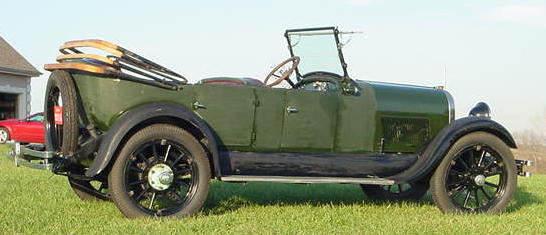 |
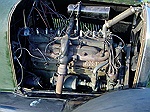 |
| 1921 6-44 Glenbrook Touring Car (David Green collection) | ||
Bigger changes came in the big six series, which was the new "Six-66". The October 1920 issue of Automobile Trade Journal had an article on the "Six-66" Series. The heart of the Paige "Six-66" was a superbly machined 66 HP Continental engine with all tolerances kept within 1/100th of an inch. The bore was 3-3/4 inches, stroke 5 inches. The big 2-3/8 inches four main-bearing crankshaft was perfectly balanced. Oil was force fed to the shaft and the connecting rods by a gear pump. Camshaft, timing gears and cylinders were still lubricated by splash. Paige had clutch and transmission building down to a science. The Paige was among the quietest and easiest shifting cars of its day. Once you were doing over 30 you could make any shift change without gear clash.
Paige engineers were just as conscientious about close tolerances and high quality in the chassis as they were in the engine and transmission. The chassis grew to 131 inches. Four sturdy cross members with gussets at vital points. Timken made axles to Paige's own specifications and exacting standards. Semi-elliptic rear springs were nearly five feet long. It had Firestone cord tires, 33 x 4-1/2 in size, ribbed tread on the front two and nonskid tread on the back two.
There were four models in the "Six-66" series, including a four-passenger sport model known as the Larchmont II, a refinement of the original Larchmont that had been introduced in early 1918. This model was easily distinguishable from the regular touring car because of the forward-sloping design of the back of the body. It had divided seats in the front and back for the passengers, much like two armchairs. Company literature included a fifth model, a limousine.
The standard body finish was Paige Blue below the belt rail and black above. The hood, fenders and running gear were black. The open models featured small side panels attached to the windshields, a second Paige trademark, while the new closed cars now had flat windshields with no side panels at all. Publicity claimed that these new cars could accelerate from 5 to 25 MPH in just 8 seconds in high gear and from 5 to 40 MPH in just 15 seconds, with a maximum speed of about 60 with good road conditions.
Hardwood frame joints were triple fastened: mortised, cemented, and then secured by screws. Each Paige body was custom fitted to the chassis, and doors were custom hung. Double strips of patent leather kept metal from touching metal or wood. There was a courtesy running board light on all models, and a rear tonneau light in both touring models. There were mahogany lockers in the four-passenger touring. The sedan had jump seats, and the limousine had a roll down divider window and telephone communications to the driver.
The big "Six-66" models could hardly be classified as medium priced automobiles. Prices ranged from $2,795 up to $3,750. The 1921 sedan was $3,750. These prices were in effect at the beginning of the year. But were adjusted somewhat downward in both series by the end of the model runs for 1921 to encourage sales in the sluggish economy.
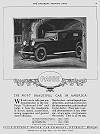 |
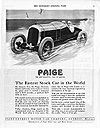 |
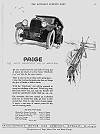 |
||
| 1921 6-66 models, Saturday Evening Post Magazine, February 5, 1921 | 1921 Daytona, Saturday Evening Post Magazine, March 5, 1921 | 1921 6-44 Glenbrook, Saturday Evening Post Magazine, March 19, 1921 |
How Enclosed Paige Bodies Are Built
Many unseen factors enter into the building of Paige enclosed bodies to make them thoroughly satisfactory in comfort and service. Their foundation is a sturdy, hardwood frame, well fastened with mortise and brackets, and braced to meet the irregular stresses of the road. Paneling throughout is sheet steel, welded at the joints so that it forms one continuous shell.
To avoid the unpleasant drumming from the roof, a heavy felt pad is laid between the frames and the outside roof covering. Doors are all braced diagonally to keep them square and each is hung by three heavy hinges. They close against live rubber bumpers, and are equipped with double latches, so that there is little possibility of accidentally swinging open.
Windows are extra heavy, polished crystal plate-glass, and slide and felt channels for silence and to prevent breakage. Door glasses are fitted with mechanical regulators holding them in any position. Rear quarter windows have heavy window straps. They lower into rubber cushions when down, and when closed are thoroughly weather-proof. Both Coupe and Sedan are provided with door locks, permitting them to be parked over a space of time without the danger of being molested. Locks are neatly installed in the door handles. Upholstering is all laid over curled hair padding and deep nested coil springs.
Company Sales Brochure
A Paige "Six-66" seven-passenger touring car climbed to the summit of Pike's Peak by the cog railroad, over ties, trestles and cattle guards, topping grades of 25 per cent or better without difficulty. Paige believed this to be the longest, steepest, highest climb ever made by an automobile.
 |
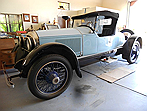 |
 |
| Owner/navigator Tom Coad and driver Gary Poulin in a 1921 racer (Tom Coad collection) | 1921 Paige Daytona (July 19, 2019, Spengy, AACA Forums) | 1921 Paige Daytona (Internet image) |
While pre-war Paige models were about as interesting than many of their contemporaries, the "Six-66" became one of the hottest cars in the country on the stock car racing circuit. Paige engaged racing car driver Ralph Mulford to serve as chief tester in the development of the 1921 models. On January 21, 1921 at Daytona Beach, Florida, a stripped down model driven by Mulford lowered the record for the measured mile to 35.01 seconds for a speed of 102.8 MPH. On May 18, 1921, at Uniontown, Pennsylvania, this car covered 89 consecutive miles in 60 minutes. In May of the following year at a track in California it covered 25 miles at a speed of 96.9 MPH.

Steve Nemesh (left) and Ralph Mulford at 1921 Pike's Peak Climb (from "American Vintage Cars" by Charles Betts)
The factory built two special models for the annual Pike's Peak Climb in 1921. The chassis were shortened and stripped for Mulford and for driver Steve Nemesh. Ralph Mulford finished in second place, 35 seconds behind the winner, with a time of 19 minutes, 51.2 seconds. (For the 1923 Pike's Peak Climb driver J. C. Allen drove one of these cars to another second place win with a time of 22 minutes, 20.6 seconds.)
As a consequence of Mulford's achievements, in April Paige announced the Daytona, a two-passenger speedster on the 131-inch "Six-66" chassis. Charles Betts (see Bibliography ) writes:
In place of the skeleton equipment ordinarily found on racy-type models, the Daytona was fitted with comfortable seats, individual fenders, windshield, folding top and other accessories, including bullet-shaped side lamps, cowl ventilator, safety latches on the doors, electric clock and muffler cutout. A third passenger could be carried in fair weather by means of an auxiliary seat which pulled out, drawer fashion, from the right side of the rear compartment, a collapsible footrest being provided on the short aluminum running board on that side. The body, which featured a tapered rear deck with a rear-mounted spare wheel, was finished in deep red enamel, with blue wire wheels and black fenders.
Even with full body equipment the new Daytona could still do 80 MPH.
Paige sales grew steadily from 1915 through 1920, when the total reached over 16,000 for the year. Sales dropped during 1921 to something under 10,000, because of the postwar depression that affected most auto manufacturers.
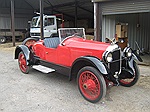 |
 |
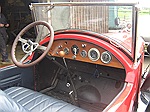 |
| 1921 Daytona (Nigel Plant collection) | ||
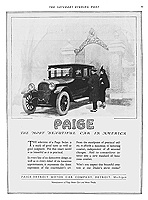 |
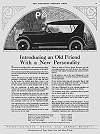 |
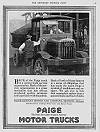 |
||
| 1921 6-66 Sedan, Saturday Evening Post Magazine, November 13, 1920 | 1921 6-42 Glenbrook, Saturday Evening Post Magazine, January 22, 1921 | 1921 Truck, Saturday Evening Post Magazine, July 9, 1921 |
Elsewhere in 1921:
- W. M. Folberth invents the automatic windshield wiper.
- Thomas Midgley and Charles Kettering identify tetra-ethyl-lead as an additive to eliminate engine knocking.
- The Pig Stand, the first drive-in restaurant, opens in Dallas.
| < 1920 | 1922 > |

